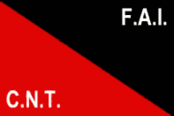Still working to recover. Please don't edit quite yet.
Confederación Nacional del Trabajo
|name= CNT
|country= Spain
|affiliation=
|members=
|full_name= Confederación Nacional del Trabajo
|native_name= National Confederation of Labour
|image=  |founded= 1910
|current=
|head=
|dissolved_date=
|dissolved_state=
|merged_into=
|office= Seville, Spain
|people= Rafael Corrales, secretary general
|website= www.cnt.es
|footnotes=
}}
|founded= 1910
|current=
|head=
|dissolved_date=
|dissolved_state=
|merged_into=
|office= Seville, Spain
|people= Rafael Corrales, secretary general
|website= www.cnt.es
|footnotes=
}}
The Confederación Nacional del Trabajo ("National Confederation of Labour" or "CNT"), founded in Barcelona, Spain, in 1910, was at one time that country's largest labour union.
It is the main Anarchist organization in Spain, and prominent in combating the coup d'état by General Francisco Franco that led to the Spanish Civil War in 1936. It is also the name of Marxist or Syndicalist labour confederations in countries from France (Confédération nationale du travail) to Panama.
Contents
History
The CNT was formed in opposition to the majority union, the socialist General Union of Workers (UGT). It began in the Catalan Anarcho-syndicalist group Labour Solidarity (born in 1908). In its First Congress (1911, the year in which the union received its new name officially), the CNT convoked a general strike, which led to the union being outlawed until 1914. From 1916, the CNT changed its strategy regarding the UGT, and began forging relations, with both unions agreeing on the organising of the 1917 general strike. The bonds were strengthened, and, at the Second CNT Congress of 1919, the idea emerged that the two unions should merge for the sake of working class unity; at the same time, a provisional link was approved between the CNT and the Leninist Comintern. But, after a visit by CNT director Ãngel Pestaña to Bolshevist Russia (the territorial nucleus of the future Soviet Union), the proposed affiliation was dropped. All links between the Comintern and CNT were severed in 1922, and the union became a member of the International Workers Association (IWA/AIT/IAA).
In 1918 the Catalan industrial crisis led to thousands of workers joining the organisation. In order to counteract the new strength of rank and file organised labor, the employers financed pistolerismo (gunfighterism) to attack union organisers. In 1923, after the rise of the dictator General Miguel Primo de Rivera, the CNT went underground. Split between the Iberian Anarchist Federation (FAI) tendency (constituted in 1927 for the sake of maintaining anarchist principles in the union) and the moderates - who formed the Syndicalist Party, its activity during that period was marked by participation in several combines against the régime. Some members of the CNT helped Pierre Besnard and other French anarchists found the CGT-SR in 1926.
Virtually identified with the cause of Anarchism in the country, the CNT had a leading role during the years of the Second Spanish Republic and Spanish Civil War (see: Anarchism in Spain).
After Francisco Franco's death and the Spanish transition to democracy, the CNT again became legal, but was not as prominent as before the war. It boycotted the system of elections for workers' representatives. This refusal caused a faction of the CNT to break away, forming the Confederación General del Trabajo.
Symbols
The CNT flag has a diagonal dividing it in one red and one black halves.
Objectives
To develop the association spirit in the workers, to practice mutual support and solidarity among the workers, to represent, to defend and to promote the economic and social interests, professionals and culture of the members, as well as the necessary actions to get social and economic improvement, as much for the members as for the workers in general.
Methods
The refusal to participate in industrial committees makes them unable to call strikes legally. They sometimes take "direct action", for example, exhibiting placards in front of a firm notorious for not respecting workers' rights, or appealing to consumers to boycott their products. The CNT does not resort to violence.
References

- José Peirats, The CNT in the Spanish Revolution, Volume 1: ISBN 1901172058, Meltzer Press, London. Volume 2: ISBN 1873976240, Christie Books, London.
- Varios autores, Anarcosindicalismo Básico (in Spanish), CNT de Sevilla, 2001
- "Basic Anarcho-Syndicalism" (Revolutionary Unionism), (Part I: The Goals and Structure of the CNT, part II: The CNT in the Workplace, Part III: The CNT's Revolutionary Principles). English in PDF-Format
Film
- Vivir la Utopia - Living Utopia El anarquismo en Espana [1] ("Living Utopia") by Juan A. Gamero, produced by Arte-TVE, Catalunya, 1997.